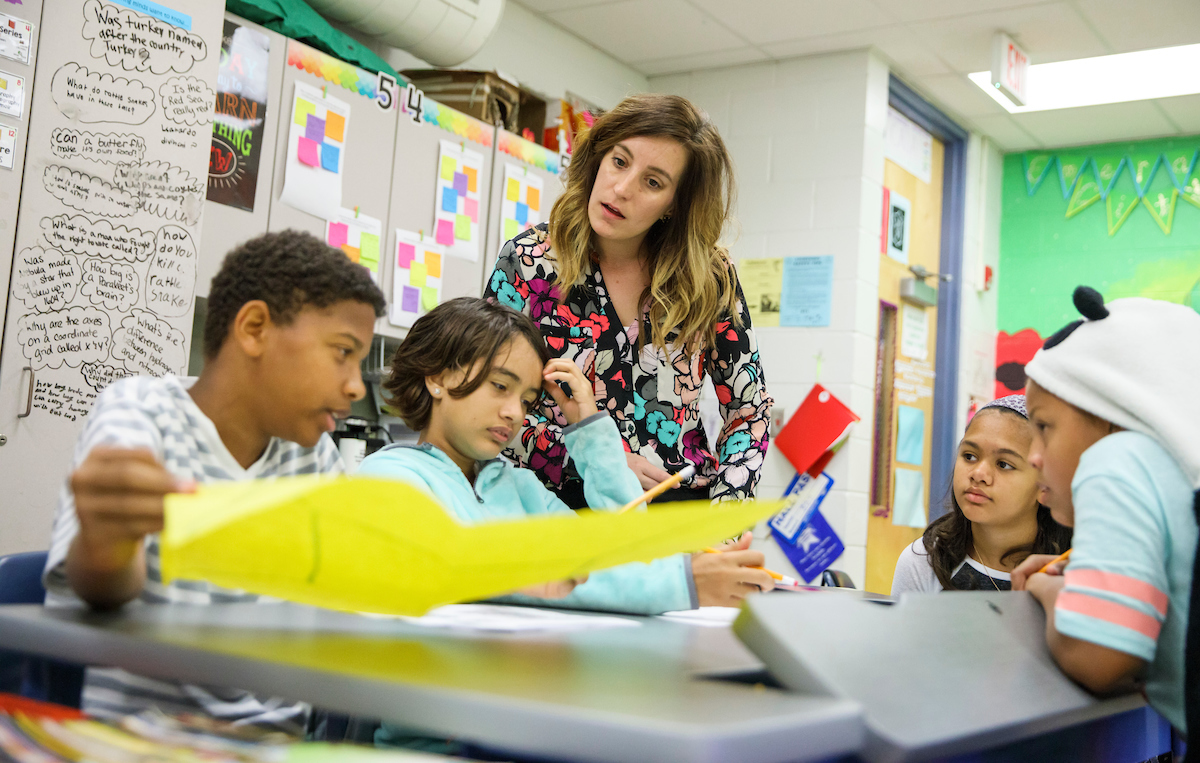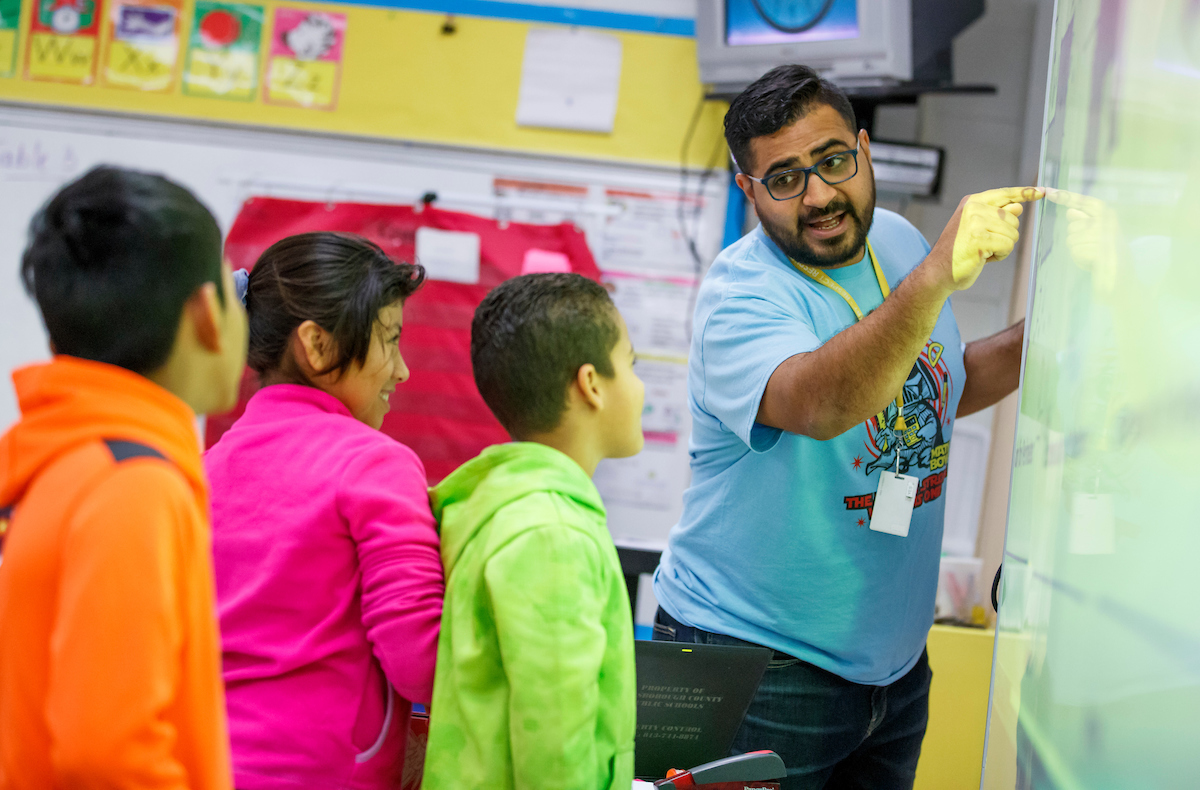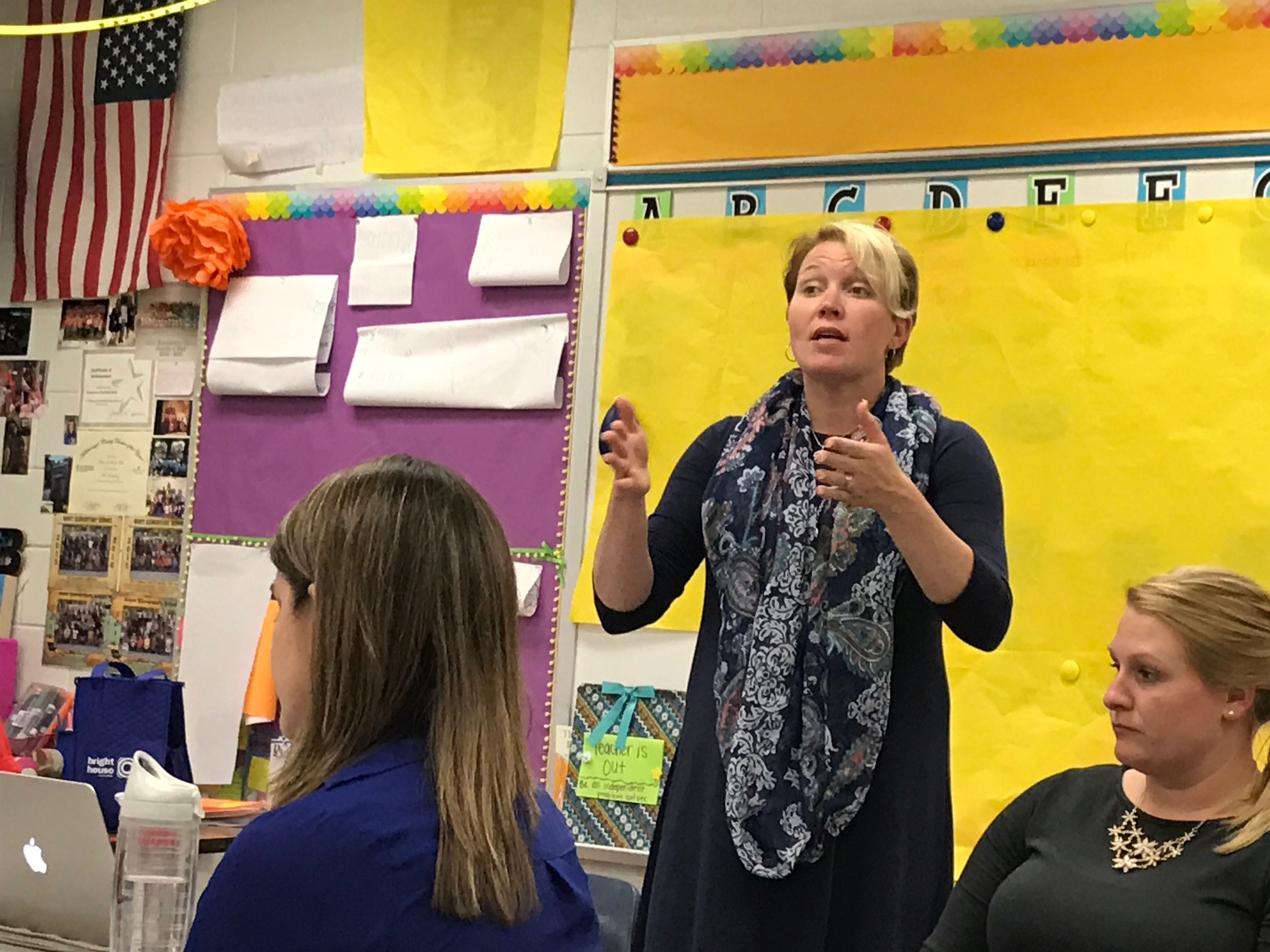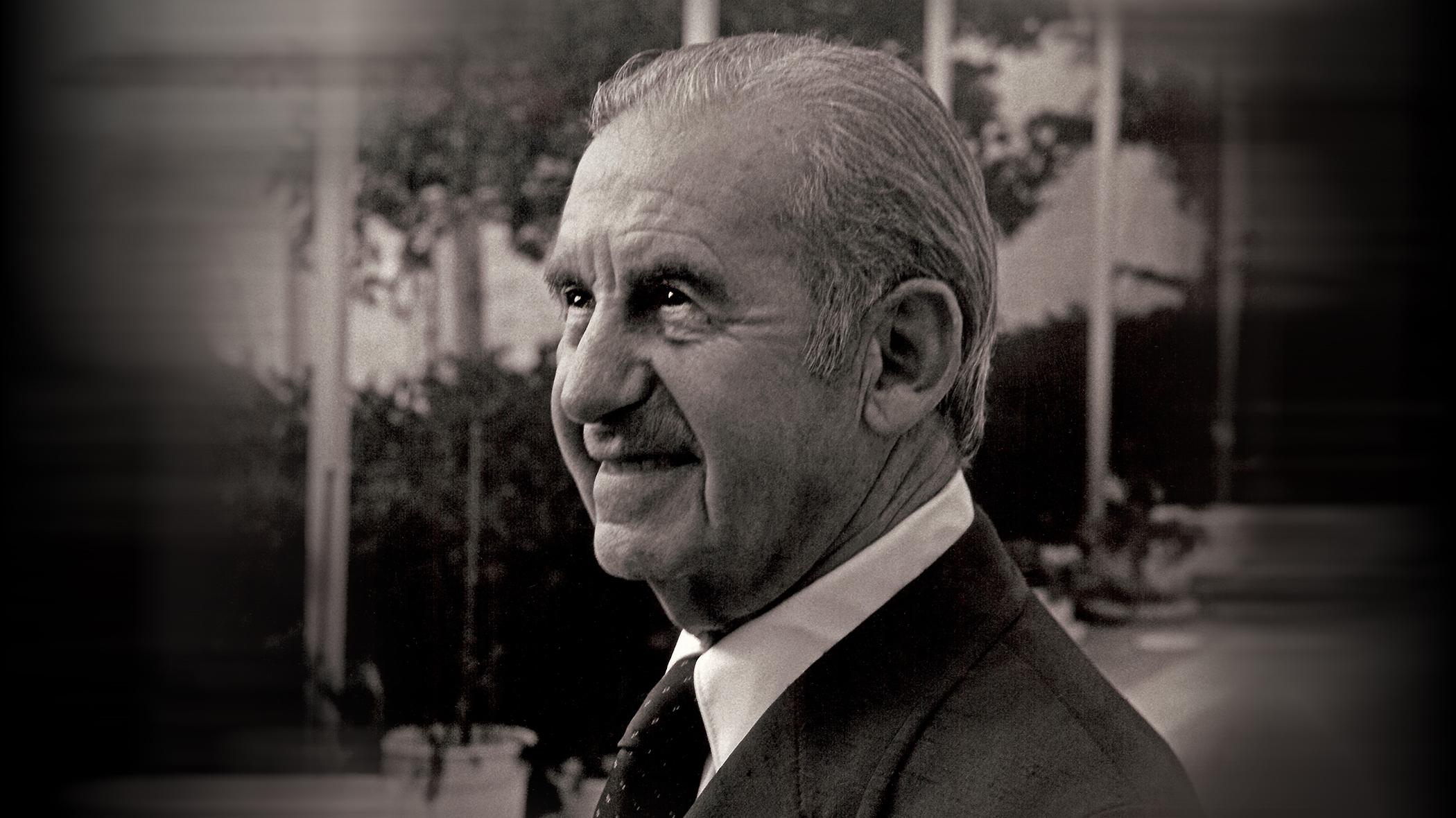
An Innovative Program from USF's Anchin Center and College of Education is Empowering Teachers and Transforming a North Tampa Elementary School
April 23, 2017
The dry-erase desktops inside a classroom at Mort Elementary contain an array of scrawled notes in multi-colored markers. You might initially mistake these as random messages and doodles by bored fifth graders. But a closer look reveals something altogether different — words of support from students to their teachers, and worlds of difference in the way educators are learning to make an impact at a traditionally struggling north Tampa school.
“I hope you have a great time. (Good luck!!!)” one child has penned.
“Have a nice day and learn a lot of stuff!” another encourages.
“Have a wonderful day and I am thankful for you!!” reads another jotting, adorned with shapes of hearts.
This isn’t a display of kids passing on cheery wishes to get on their teachers’ good sides after forgetting to do their homework.
On the contrary, the uplifting sentiments are intended to encourage instructors as they participate in an innovative four-year-old program called the Teacher Leadership Academy — a faculty-driven initiative from the University of South Florida that is yielding significant results on multiple Mort fronts.
So what is precisely going on here? The short answer is that the TLA is designed to provide professional development classes and advanced certification to teachers within the school. It allows them to work toward master’s degrees while training other teachers at Mort on problem-solving and effective educational techniques in weekly after-school sessions.
As the name suggests, the program empowers them to take the lead, build confidence, feel more engaged and devise the best ways to connect with students — rather than simply following outside directives and presentations that aren’t necessarily tuned in to the specific issues facing Mort.
Ultimately, the Teacher Leadership Academy could become a model for other schools within Hillsborough County and neighboring counties, as well as a potential blueprint for broadening teachers’ abilities and student success rates anywhere in the country.

No endeavor of this magnitude could happen without a vision, commitment and passion to pave the way, and the cast in this story typifies all of those traits. It includes an inventive young USF professor, a veteran Hillsborough County public school educator — and, not to be overlooked, a man who came to America as a child at the turn of the 20th century, rose from poverty to financial heights and decided to make the education he was denied in his native Russia the focal point of his life.
Their names all play a key part in the narrative of this unique program: USF assistant professor Rebecca “Becci” Burns, who devised and oversees the leadership academy; Mort Principal Woodland Johnson, who was determined to engineer positive and creative change, and believed in Burns’ novel approach; and the late David C. Anchin, a businessman and philanthropist whose name graces the Anchin Center at USF’s College of Education, which has provided the foundational support for the program to take root and flourish.
“Every time Principal Johnson and I present our work at meetings or conferences, people say, ‘How did you do that? — like it was almost magic,” says Burns. “But essentially what we’re doing is preparing our teachers, so they can learn to become leaders and be more greatly invested in the process. And we’re teaching them to carry on this work, which will help renew schools wherever they may go.”
Right now, the spirit of renewal at Mort is alive and well — as evidenced, in small part by the desktop messages.
“I told my kids earlier in the day, ‘We have to clean up because there will be a teachers’ meeting in here right after school — we want it to look the way it would if your mom walked into your bedroom,” says fifth-grade instructor Francesca Perrone-Britt. “They asked, ‘Why are the teachers coming to a meeting?’ And I explained that it was teachers teaching teachers — that just like students always need to learn and get better, so do we.”
The students were fascinated by the thought. And all they wanted to do, Perrone-Britt recalls, was to write notes that would give their teachers a smile as they arrived for class.
***
Amanda Bellas sits in a teacher’s planning room minutes before the next session in leading professional development is set to begin. Bellas has been a teacher at Mort for five years, starting in the classroom, and then becoming a mentor or “collaborating teacher” as part of the USF teacher residency program. That’s how she got to know Burns, whose first job was at USF after earning her doctorate in education from Penn State University.
“When I heard of the plan that Becci and our principal were going to implement, I knew it was something that would push us forward — something different than the norm,” Bellas recollects. “The typical way is that you sit in a room for professional development and really just listen to somebody talking to you, giving you information, and then you walk out and do your best to put it to use. It had been very traditional here just as with any school: coaches were the experts and you went to them for help if you needed it, but as far as being a leader, it was the principal — and not the teachers.
“But this new approach was so different from the start. It was really unscripted, like, ‘Hey, this is our plan, designed specifically for us.’ So we dove in head-first with Becci and our principal. And they were telling us, ‘We want you to be part of this shared leadership among classroom teachers and teacher coaches. And suddenly we felt like, ‘Wow, what a shift this is!’ It was a completely new way to work and learn.”
Today, Bellas is one of several dozen teacher leaders at Mort, an instructional coach who spends half her time in the classroom with students, and the other half on coaching duties — working with teachers regardless of how many years they have on the job.

The basic approach they follow was one Burns immersed herself in at Penn State, working with public-school teachers as part of her doctorate, with a special focus on professional development.
“Think of it this way: Most times teachers learn something new and then go apply it in their classrooms,” she explains. “What we do with TLA is the reverse: We take whatever real issues teachers are facing, and say, ‘Okay, let’s figure out what’s going on, what could be done better and how we are going to fix it together?’ We’re connecting what we do to theory, rather than learning theory and connecting that to practice.”
There’s a crucial by-product of that system: Teachers feel a greater sense of ownership on the job, steady support from their peers and superiors, and an increased understanding of how to get through to their students. “These are teachers who never led any kind of professional development, never facilitated any kind of peer learning,” Bellas says. “But now they are being taught the skills to become agents of change.”
***
Looking back, it almost seems as if the paths of the like-minded teacher-trainer and principal were destined to cross, forging an alliance to further that change.
Much of Burns’ time at Penn State was spent working in — and with — elementary schools. She focused on learning and understanding the values associated not only with preparing high-quality teachers but on working collaboratively with teachers and school administration. When she joined USF’s College of Education staff in 2012, Burns arrived with the ideal credentials and the nonstop energy to start the Teacher Leadership Academy. Anchin’s previous director, Diane Yendol-Hoppey, had embraced the general concept of a teacher leadership development program, but it was Burns who gradually made it happen. She began building relationships with local schools and spending time each week at Mort, supervising undergraduate student-teachers from USF.
The school had a brand new principal as well, a creative thinker who had worked as a teacher and administrator at a variety of Hillsborough County elementary schools — though none as challenging as his present job. Located in one of the poorest neighborhoods in the county, nestled on busy Bearrs Avenue amid low-cost rental housing, Mort has some 800 students, more than 95 percent of whom qualify for free lunch. Roughly half of the student population is Hispanic and many of the students are learning English for the first time.
Johnson came into the job determined to start a turn-around, and he promptly encountered Burns, touting her novel approach to teacher professional development. At first, he was wary. “Principal Johnson wasn’t used to the kind of relationship with someone like me, coming from the university and believing in collaboration, and that individual voices should all be at the table,” Burns remembers. “And I wasn’t used to traditional ways of training teachers. But we started talking and getting to know one another — and realizing we had a shared interest and common vision. We each cared deeply about the kids and about education. On top of that, we cared about making a difference for teachers and finding ways to empower them.”
One serious problem at Mort was teacher retention. Given the school’s many issues, the turnover rate was particularly high, prompting Burns to pitch her idea of training teachers as leaders to Johnson. “I’m sure he was like, ‘Who is this woman who keeps calling me?’ ” she says with a laugh. But Johnson recognized her passion, academic credentials and experience working in the field, so he listened and a solid partnership was formed.

“I knew there needed to be a way to bring our teachers more into the process, while giving them a chance to further their degrees,” he says. “So Becci and I really wanted to address the issue of teacher retention, making sure that we could find a way to keep our core teachers, and prepare them to do other things. That really gave birth to the program here. It stemmed from a process of getting to know Becci, working with USF and getting acquainted with the people there as well. We had a program that was different from the norm — and we knew we needed to get people in the community vested and invested in developing teachers.”
Johnson and Burns began by working with USF to implement a teacher leadership certificate, building on groundwork laid by former director Yendol-Hoppey. This way, teachers at Mort could participate in the academy and their efforts would simultaneously count toward a master’s degree. Another benefit: Their weekly sessions always start immediately after school lets out, allowing them to attend training within their required work day — and without any evening or weekend hours required. The work is paying big dividends. Teacher morale is high. Kids are eager to learn. And the school has gone from an F grade to close to a C in short order, with all indications that the upswing will continue.
“We have a waiting list of teachers who want to come here and be part of our program,” Johnson says. “And I will tell you that from the things we have implemented in the Teacher Leadership Academy, there is a direct correlation to how the kids are doing in the classroom. We’re a little over 50 percent turnover rate in our students each year, and that’s significant. Yet, we are seeing growth in their test scores, which is very encouraging.”
Another indicator of success is the reduction of student suspensions. In Johnson’s first year on the job, Mort logged more than 500 suspensions in school and out of school annually. “We are down in each of those categories this year to maybe five or six,” he says. “That doesn’t mean we don’t have issues — we do. But we are making great progress.”
Mort’s turnaround has also been spurred by other initiatives, such as its transformation under Johnson into a community partnership school, which offers such programs as parenting classes, a student leadership effort to enhance communication skills, a food pantry to supplement dietary needs and a clothing distribution outreach — initiatives supported by area businesses and local government. “We really do wrap-around services here, because of the community school model and all that we’re doing,” he says. “We look at the needs of the kids and families here, and put them in a situation where they can feel hope for the future.”
Dr. Roger Brindley, dean of USF’s College of Education, credits Johnson and the school administration for the “vision” to collaborate in the partnership with the university — and for its high level of community engagement.
“The TLA at Mort Elementary School is an exemplary program,” he says. “It utilizes multiple stakeholders from the College of Education and the Anchin Center, but just as significantly from the residential community, from the local government and health agencies, and the parent base of the children who attend the school. As the result of working together as a large community, our pre-service teachers see practicing teachers as models. And those practicing teachers get to have tremendous professional development opportunities.
“And above all else, the children in the school benefit from focused, engaged, motivated professionals working around them and showing them that they can succeed and can achieve.”
The biggest hurdle for the Teacher Leadership Academy to keep it going and growing, however, is funding. “We’re spending about $40-$45,000 a year on the program – and most of that has come from fundraising,” Johnson says. “So in order to perpetuate and expand it, we have to figure out ways to keep funds coming in.”
Of course, without a certain philanthropic investment in USF’s College of Education some 30 years ago, the program would likely not exist at all.
***
A glass kiosk in the lobby of the Anchin Center, nestled alongside the College of Education, holds a briefcase and a story. The artifact once was carried by David C. Anchin, and his legacy of hard work and a hunger for education has carried on through the decades.
Anchin’s father always encouraged his son to invest in his mind, because nobody could ever take away his education. To help support his family in New York City, Anchin delivered newspapers before school, eventually earning a graduate of accountancy degree from City College of New York, a Bachelor of Laws degree from Fordham University and a Master of Law from New York University — while working by day and attending classes at night.

He went on to found a successful accounting firm, and began a life of philanthropy. According to his official bio, his wife, Anne, established the David C. Anchin Center for the Advancement of Teaching in his memory. “He wanted to give something back to this country because he felt so privileged that he was able to go to school,” she once said. After the Anchins moved to Sarasota, he was eventually dubbed “an angel of the school system” as a mentor and administrator, and the couple established programs to help at-risk children.
He had no personal connection to USF, but one day in the late 1980s made an unannounced visit to College of Education Dean William “Bill” Katzenmeyer. The dean, in his oral history of the college, remembered the visitor’s first words: “I am David Anchin, and I am here to help you.” Katzenmeyer was in the midst of two big projects: a place within the college that would honor and support teachers, and a program to develop the next generation of educators. The latter project led to the establishment of scholarships to assist USF students with financial needs. The former led to a collaboration between Katzenmeyer and Anne Anchin to create the center upon her husband’s death in 1990.
The Anchin Center opened seven years later, featuring the David C. Anchin Endowed Chair of Education and supported by the couple’s daughters, Ruth Hochman and Isabel Becker, as well as eight grandchildren. Today, many of the paintings and art adorning the center are the works of Anchin family members. But their most important works come in the form of the center’s mission of professional development for teachers, exemplified by the Teacher Leadership Academy.
“My father always liked to encourage independent thinking, because he believed it fostered growth," says Ms. Becker, a Sarasota resident. “He was also very interested in supporting teachers and anything that would enable them to become better at their jobs — that's a central part of the mission of the David C. Anchin Center. So I'm sure he would have been very pleased by this program."
Anchin Center Director David Allsopp and Assistant Director Stacy Hahn are thrilled with the program’s results, and one of their goals is to secure financial support to sustain the ongoing work by Burns and Johnson.
“Traditionally, struggling schools have been turned around by putting a really strong principal in place,” says Hahn. “But often those principals are eventually moved to help another school, and then you see the grades drop at the school they just left. The TLA is a one-of-a-kind program designed to keep that from happening, by giving the teachers the skills and power to maintain the curriculum and structure they have built as leaders — not just followers.”
The result is that a school like Mort can be stabilized, because the change is truly directed from the bottom up.
“It’s absolutely huge that this is a certificate program and embedded in the job,” Hahn adds. “That means the teachers don’t have to come here to USF at night to work on advanced degrees. The training is delivered on campus. And they develop a syllabus built with input from the principal and the faculty, ensuring that it reflects what is really happening in the school. The teachers study the challenges, and learn how to solve them using theory and practice.”

The word of the TLA is not going unrecognized, either. In November, Burns won the 2016 USF Community Engaged Teaching Award for her work at Mort. She, along with Principal Johnson and a group of Mort's teacher-leaders (Bellas, Perrone-Britt and Kristen Hodges) will also be receiving te Claudia A. Balach Teacher Research Award from the American Education Research Association's Professional Development School Special Interest Group. The award honors their commitment to teacher inquiry and collaborative study. Perrone-Britt — Mort's 2015 Teacher of the Year — reflected on the profound change created by the TLA.
“Before the program was implemented, I felt stagnant with my professional development, almost complacent,” she says. “I’d go to training sessions and maybe get a little out of them, but I wasn’t challenged or stimulated. But with this program, it fully engaged me and other teachers, too. It wasn’t like an addition to my day — it was an enhancement to my day. That’s because Becci knows our school's needs and is invested in what we do, and we have the full involvement of Principal Johnson.
“What we have now is a community of learning. It’s not just about my students or other teachers’ students — but our students.”
And the little messages they write say it all.
